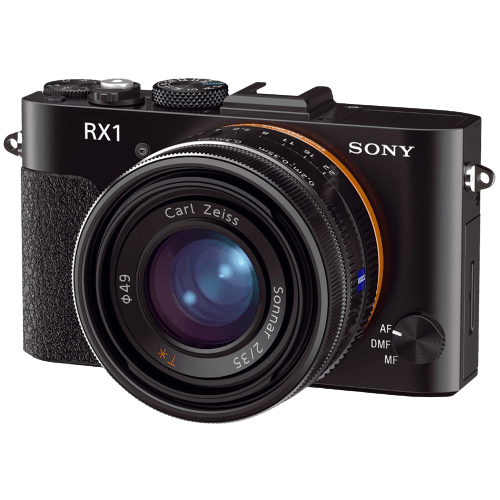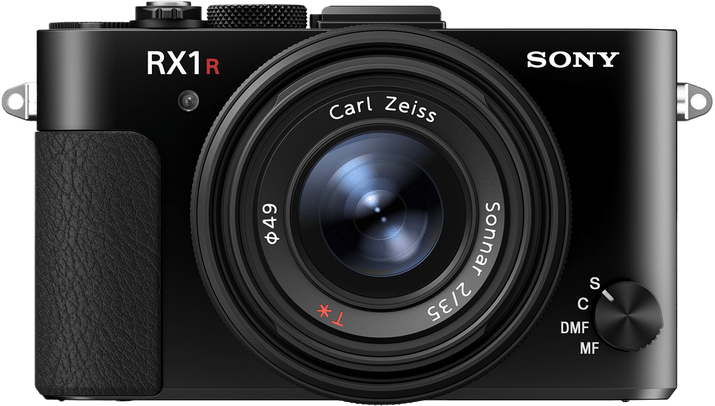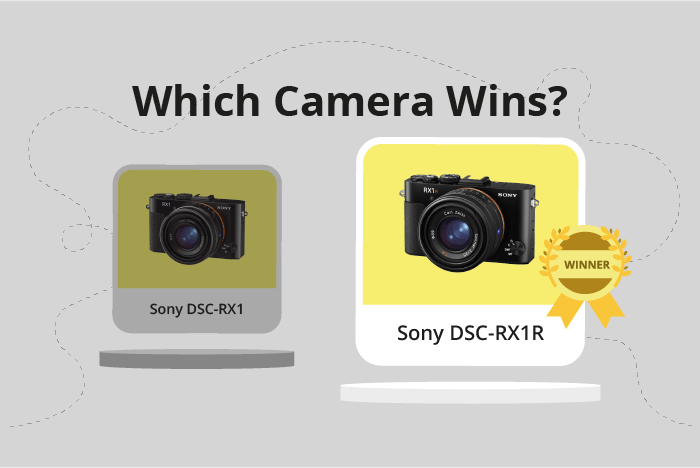Sony Cyber-shot DSC-RX1 vs Cyber-shot DSC-RX1R Comparison
Sony Cyber-shot DSC-RX1

Sony Cyber-shot DSC-RX1R

The Sony Cyber-shot DSC-RX1 and the Sony Cyber-shot DSC-RX1R both score 57/100, showing that they are highly comparable in terms of general specifications. They share the same compact camera type, launch price of $2800, dimensions of 113 x 65 x 70mm, and weight of 482g or 1.06lbs.
The DSC-RX1R has a slight edge, being released in 2013, a year after the DSC-RX1’s 2012 release. This newer model may offer some updated features and improvements over its predecessor. However, the DSC-RX1 remains a solid choice, as it shares identical specifications with the DSC-RX1R in many aspects.
Ultimately, both cameras are highly similar, and the choice between them will depend on personal preference and any specific features unique to each model.
Sony Cyber-shot DSC-RX1 vs Cyber-shot DSC-RX1R Overview and Optics
When comparing the optics of the Sony Cyber-shot DSC-RX1 and the Sony Cyber-shot DSC-RX1R, both cameras have the same score of 67/100. This indicates that their optics are on par with each other. Both cameras share several specifications, such as 24.3 megapixels, a shooting speed of 5, a CMOS sensor type, a Bionz processor, a full frame sensor size, and a fixed lens mount. Additionally, neither camera has image stabilization.
The Sony Cyber-shot DSC-RX1 has a slightly higher DXOMARK score for the sensor, at 93, compared to the RX1R’s score of 91. This means the RX1’s sensor performs marginally better in terms of overall image quality. However, the difference in scores is minimal, and both cameras still deliver impressive image quality.
On the other hand, the Sony Cyber-shot DSC-RX1R, despite having a slightly lower DXOMARK score for the sensor, has its own advantages. For instance, its low-pass filter has been removed, which results in sharper and more detailed images. This feature is particularly beneficial for photographers who focus on landscape and architectural photography.
In light of these factors, both the Sony Cyber-shot DSC-RX1 and the Sony Cyber-shot DSC-RX1R have their own strengths and weaknesses. The RX1’s slightly higher sensor score contributes to its overall image quality, while the RX1R’s removal of the low-pass filter enhances image sharpness and detail. Ultimately, the choice between these two cameras depends on the specific needs and preferences of the photographer.
Sony Cyber-shot DSC-RX1 vs Cyber-shot DSC-RX1R Video Performance
The Sony Cyber-shot DSC-RX1 and the Sony Cyber-shot DSC-RX1R both have identical video scores of 56/100. This means that neither camera is superior to the other in terms of video capabilities. Both cameras share common specifications, which contribute to their equal video scores.
The shared specifications between the two cameras include Full HD video resolution, maximum video dimensions of 1920 x 1080, and a maximum video frame rate of 60fps. Additionally, neither camera has built-in time-lapse functionality. These specs provide users with a clear and consistent video quality across both models.
Despite their equal scores, there may be specific features in each camera that could make one more suitable for certain users or situations. However, based on the provided information, neither the Sony Cyber-shot DSC-RX1 nor the Sony Cyber-shot DSC-RX1R has any advantage over the other in terms of video capabilities. Both cameras offer the same level of performance and quality for video recording.
To conclude, the Sony Cyber-shot DSC-RX1 and the Sony Cyber-shot DSC-RX1R have identical video scores and specifications, making them equally suitable for users seeking a camera with reliable video capabilities. The choice between the two will ultimately depend on factors other than video performance, as both cameras excel in this area.
Sony Cyber-shot DSC-RX1 vs Cyber-shot DSC-RX1R Features and Benefits
The Sony Cyber-shot DSC-RX1 and the Sony Cyber-shot DSC-RX1R both have a feature score of 44/100, making them equal in this aspect. They share several common specifications, such as a 3-inch screen size, a screen resolution of 1,229,000 dots, the absence of a touchscreen, the presence of a flip screen, and the lack of GPS and Bluetooth.
The DSC-RX1R stands out as it comes with built-in WiFi, offering users more flexibility in transferring and sharing photos. This feature makes it easier to connect to other devices and upload images directly to social media or other platforms. The presence of WiFi in the DSC-RX1R gives it an advantage over its counterpart.
On the other hand, the DSC-RX1 does not offer any specific advantage over the DSC-RX1R, as they share the same feature score and most specifications. The lack of WiFi in the DSC-RX1 can be seen as a disadvantage, as it limits its connectivity and sharing capabilities compared to the DSC-RX1R.
Taking into account the shared specifications and the WiFi advantage of the DSC-RX1R, it can be concluded that the DSC-RX1R is a better choice for users who value connectivity and ease of sharing. The DSC-RX1, while not offering any distinct advantages over its counterpart, still remains a decent camera option for those who do not prioritize the WiFi feature.
Sony Cyber-shot DSC-RX1 vs Cyber-shot DSC-RX1R Storage and Battery
The Sony Cyber-shot DSC-RX1 and the Sony Cyber-shot DSC-RX1R both have the same storage and battery score of 16/100. They share identical specifications in this category, including a single memory card slot, compatibility with SD/SDHC/SDXC and Memory Stick Pro Duo/Pro-HG Duo cards, a battery life of 270 shots, and the use of an NP-BX1 battery type. Neither camera offers USB charging capabilities.
Since both cameras have the same score and identical specifications for storage and battery, there is no winner in this category. The Sony Cyber-shot DSC-RX1 and the Sony Cyber-shot DSC-RX1R are equal in terms of storage capacity and battery life, making them equally suitable for users with these requirements.
Sony Cyber-shot DSC-RX1 vs Cyber-shot DSC-RX1R – Our Verdict
Are you still undecided about which camera is right for you? Have a look at these popular comparisons that feature the Sony Cyber-shot DSC-RX1 or the Sony Cyber-shot DSC-RX1R:

